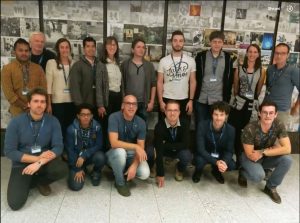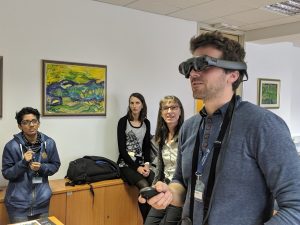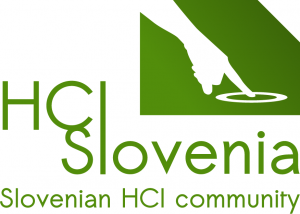Due to popular request … you know how this goes. 🙂
New deadline for our HCI-IS conference is 10 September 2020.
See you soon!

Due to popular request … you know how this goes. 🙂
New deadline for our HCI-IS conference is 10 September 2020.
See you soon!
We had a wonderful time last year. Welcome to join us this year!

For details, see call for papers – click here.

human computer interaction in information society 2019
Human-computer interaction in information society is a conference organized by the Slovenian HCI community. The purpose of the conference is to gather researchers, practitioners and students in the field and offer the opportunity to exchange experiences and research results, as well as to establish contacts for future cooperation.

human computer interaction in in formation society 019
This year’s fourth reincarnation of the conference is, for the first time, organized by the newly established SIGCHI Chapter ACM Chapter Bled, which is partly a result previous
conferences. The growth of the HCI community in the region is also witnessed by the doubled number of contributions coming from all major higher education institutions in Slovenia and abroad.
The topics covered by the conference range from the more established ones, such as usability testing, visualization and design of graphical user interfaces to virtual and augmented reality, user interfaces in healthcare, automotive industry, arts and e-learning.
You can view the full proceedings and some photos of the event.

After a short brake, the Slovenian HCI community is back with the Human-Computer Interaction in Information Society. As always, in October in Ljubljana, Slovenia.

This is the first edition since ACM SIGCHI Chapter Bled Slovenia was established. All you need to know is listed in the CFP available here.
We are waiting for your contribution – full research papers, work in progress, demonstrations – until the end of summer (30.8.2019). The conference takes place on Wednesday, the 9th of October.
See you soon!
Jan Štrekelj, Branko Kavšek
University of Primorska Faculty of Mathematics, Natural Sciences and Information Technologies Glagoljaška 8, 6000 Koper, Slovenia
Abstract: This paper describes the concept of virtual reality and the use of this technology in practice. The main part of the work is about reviewing the various stages of the development of a prototype system for interactive video management by means of an exercise bike. Systems, that are currently available on the market, are, due to their ease of use, closed units, for which upgrades are not possible or come at a great expense. The main advantage of the presented prototype, besides affordability, is a simple option to upgrade the system by adding sensors and/or modules; this allows us to extend the system in every stage of development. A low-cost computer (Raspberry Pi) is used as a processing unit, for calculating the speed of the wheel and sending this information to the control unit. The control unit processes the received data and sets the playback speed of the video clip accordingly. There is great potential for improvement on the developed prototype. Thus, ideas for further development are presented in the concluding section.
Presentation: 
Erik Šimer, Matjaž Kljun, Klen Čopil Pucihar
University of Primorska, FAMNIT, Glagoljaška 8. Koper, Slovenia
Abstract: Since ancient times travelers and tourists try to leave their marks in places they visit. However, carving or writing on historic landmarks can cause irreversible damage on such sites. One possible solution are digital graffiti. These can for example be created through projection mapping where beams of light wrap the object with the digital graffiti created by users so everyone at the site can see them. However this may disturb other visitors being there at the same time. In this paper we explore an alternative solution for creating digital graffiti by utilizing Mobile Augmented Reality (MAR) technology. We developed a mobile application which allows users to: (i) select an object or a building, (ii) map a 3D mesh onto it in order to prepare its 2D plane , and (iii) draw a graffiti on this plane. After completing the drawing the application wraps the object or the building with a modified 2D texture creating an illusion of digital graffiti. In order to (i) evaluate the social acceptance of placing digital graffiti onto historic landmarks and to (ii) evaluate if the use of our prototype is socially acceptable in public spaces, we carried out a small reflective user study. We created a couple of simple graffiti on different historic buildings and posted them on social networking site Facebook. Despite amateur appearance, posted photos received attention and generated some positive responses and questions.
Gal Pavlin
University of Ljubljana, Faculty of Electrical Engineering Trzaska 25 1000 Ljubljana
Marko Pavlin
Jožef Stefan Institute, Jamova cesta 39, 1000 Ljubljana, Slovenia
Abstract: In this paper, we describe first prototype of mobile crowd sensing device. The device serves as a source for signals in the potential crowd sensing studies. Presented device has no intention to compete with the existing mobile devices, such as mobile phones, but to complement them where they lack of the features like affordability, simple use and new opportunities in different segments of our lives. Our main goal was to develop a device, which can cover all aspects of mobile crowd sensing and at the same time to keep the device cost at very affordable level. The described device is capable of integration into most widely available sunglasses. The complete device consisting of two separate “lenses” forms distributed ecosystem serving as source for sound, light, acceleration and temperature signals while at the same time providing actuator function with integrated LED matrix display.
Presentation: 
Žiga Kopušar
Guardiaris d.o.o., Podjunska ulica 13, Ljubljana, Slovenia
Franc Novak
Jožef Stefan Institute, Jamova cesta 39, 1000 Ljubljana, Slovenia
Abstract: In this paper, we describe a case study of usability testing of the GUARD Control Desk graphical user interface, which is a part of the GUARD simulator and is used for exercise planning, execution and evaluation in soldier training. The usability testing was performed in the development phase of a new version of user interface.
Presentation: 
Blaž Gombač, Matej Zemljak, Patrik Širol, Damir Deželjin, Klen Čopič Pucihar, Matjaž Kljun
University of Primorska, FAMNIT, Glagoljaška 8, Koper, Slovenia
Abstract: In recent years the field of virtual reality has witnessed a rapid growth with significant investments in both hardware and software development. It has several potential applications for entertainment, education and enterprise where users benefit from being immersed into virtual worlds. VR headsets are available in several forms and price ranges from simple and inexpensive Google Cardboard to more complex products such as Oculus Rift. Nevertheless, designing fully operational virtual reality applications for researching new complex multimodal interaction possibilities (e.g. mid-air gesture, voice, haptics, etc.) may be difficult to implement, costly and time consuming. For this reason we have looked into ways of rapidly prototyping virtual reality interactions. Our approach consists of the Wizard of Oz experiment in which subjects interact with a computer system believing to be autonomous, but is in reality operated by researchers. The presented system allows non-technical designers to explore various multimodal interactions with rapid prototyping of VR environments.
Andrej Maleckar, Matjaž Kljun, Peter Rogelj, Klen Čopič Pucihar
University of Primorska, FAMNIT, Glagoljaška 8, Koper, Slovenia
Abstract: With the ever increasing connectivity to the Internet the use of the web has spread from static environments of desktop computers to mobile context where we interact with the web though laptop computers, tablet computers, mobile phones and wearable devices. Recent studies have shown that young people access the web using various devices and input techniques and spend on average more than 20 hours a week on the web. In this paper we plan to investigate which input technology is most usable or preferred for performing different tasks on the web. We decided to compare and evaluate the usability of the three most used input devices for web browsing, namely: a computer mouse and a touchpad on a laptop, and a touchscreen on a smartphone. For this purpose we have built a custom web page where users had to perform seven common tasks on web: open a URL address, copy/paste a URL address, copy/paste text, scroll up-down, scroll left-right, zoom in the context of a web page, and navigate a map. The results show that the mouse is still a preferred input device with shortest completion times, followed by the touchscreen interface even if it performed slower at some tasks compared to touchpad, which was marked as least preferred.
